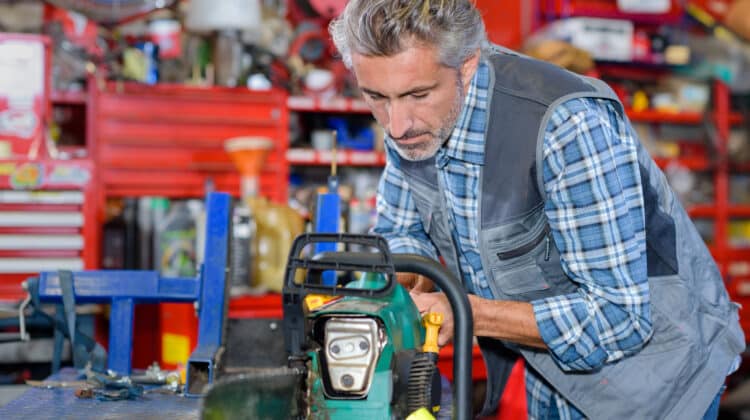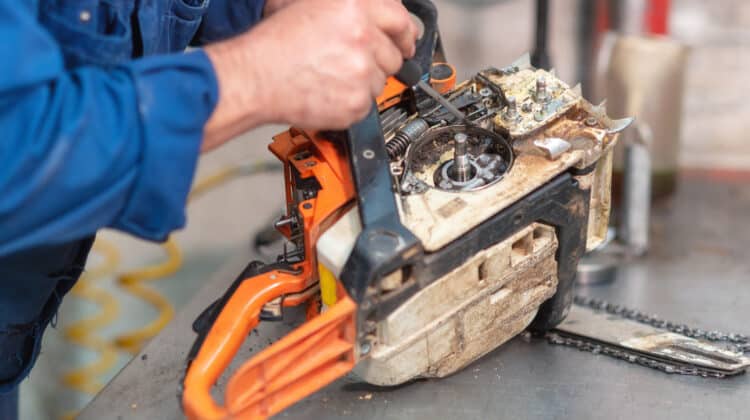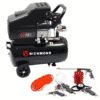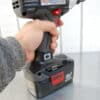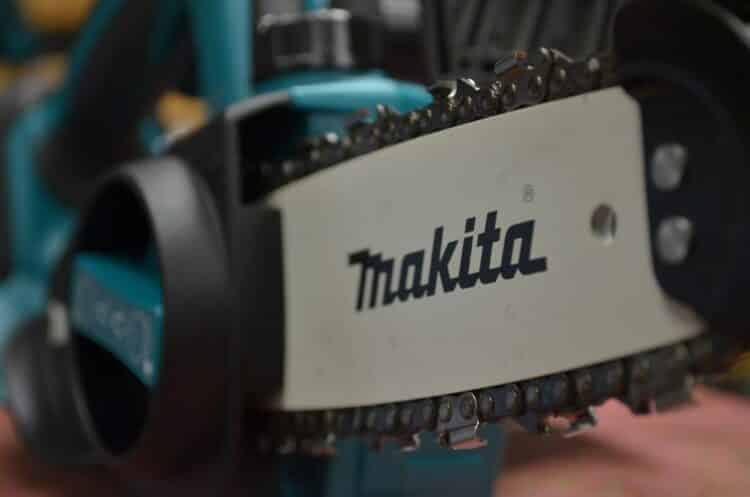
Suppose you are experiencing difficulties with the chainsaw coil. Read below to learn how to test a chainsaw coil. We’ll walk you through the process in 14 simple actions.
In the user handbook for your chainsaw, find the suitable resistance reading for your chainsaw.
Find the chainsaw coil and remove it. Attach the negative and positive cords of the multimeter to both positive and negative coil plugs in the chainsaw. Afterward, check the resistance that is reflected there.
Below are detailed steps on how you can use the chainsaw coil:
Table of Contents
Safety Precautions:
First and foremost, be sure to wear a sturdy pair of protective clothing (you can use a couple of protective gloves, rubber). You must also ensure that you are wearing safety glasses. To avoid getting electrocuted, it is essential to use insulated pliers. This will prevent the current from flowing through them. Check to see if the chainsaw has been switched off.
When it comes to chainsaws, the position of the ignition coil might differ from one version to the next. Almost all the designs have it situated close to the supplier. For safety considerations, a cover (plastic) may be employed to cover the coil; gain access, the body must be removed.
Disconnecting & Spark Plug Testing:
Unplug one of the sparks plug wires from the ignition system of the chainsaw before continuing. These wires flow from the distributor cover in most vehicles to the spark plug. As a result of only 1 or 2 screws holding those wires in position, they are pretty easy to disconnect.
To detach these cables, you’ll need a variety of essential tools on your workbench. Because the chainsaw motor may get quite hot, make sure you always wear your protective clothing when operating it.
Allowing the chainsaw to rest. It should cool down in nearly 15 minutes and can help to avoid any significant harm from occurring.
If feasible, use a spark plug analyzer to ensure that its not broken and save time in the future if this is the case. Instead of linking the spark plug detector to the chainsaw’s coil wires, you should try attaching the spark plug tester into the circuits of the chainsaw’s coil instead. You will need to power up the alligator clips first. Then rev the engine to determine whether there is any ignition in the space between the tester and the machine.
It will also assist you in preventing debris, dust, butterflies, other insects, or twigs. Using the spark plug tester or analyzer prevents such objects from going inside the chainsaw’s combustion chamber.
There are also other 2 ways on how to ignite a spark plug: more technical & less technical process.
More Technical
- Carefully remove the outer cover of the saw to see the spark plug.
- Disconnect the spark plug from the ignition system.
- Connect one end of the alligator clip wire towards the spark plug boot, ensuring that the clip comes into contact with the metal conducting surface within the boot.
- Install the other end of the alligator clip wire into the hot end of a digital multimeter and check for continuity.
- Use your ground probe on the multimeter to make contact with a suitable metal surface ground.
- Set the multimeter to 20 volts of direct current.
- Move the saw to the side and wait for the multimeter to respond. Inconsistent readings indicate that it is operational, that there is no activity, and that the ignition is not functional.
Less Technical
- Carefully remove the top cover of the saw to see the spark plug.
- Disconnect the spark plug from the ignition system.
- Put the spark plug wire on the spark plug but do not position the spark plug into the cylinder; instead, keep it hanging loosely in the air.
- With one arm, grasp the threaded metal portion of the spark plug and draw the saw over with the other.
- If you experience a shock, the ignition will activate.
- If working in bright light and can’t see the spark immediately, I’ll resort to this approach occasionally. It yields a highly favorable yes or no response from the user.
How To Disconnect/Detach Spark Plug
It is required to eliminate the spark plug from your chainsaw using a spark power socket, which is a particular type of tool to do this. Keep any dirt, debris or dust from falling into the opening where you removed the spark plug from the ignition system.
Anything that remains within the opening may cause significant damage to the whole of your chainsaw engine. Therefore, you should let this opening permanently sealed with a strip of clean cloth to avoid anything from dropping into the combustion opening of the chainsaw.
If the spark plug is not looking to be in an excellent condition or is damaged, you need to upgrade it.
The Primary Ignition Of A Circuit Must Be Checked
When it comes to sparking plugs, now is an excellent time to replace them if they are not in outstanding form. Many chainsaws have both positive and negative terminals on the coil. It is clearly indicated with the figures + or -.
On the other hand, some contain two wires positioned at the connections of their devices. The central resistance limit of a chainsaw coil is typically 0.40 – 2 ohms. But, remember you should investigate the precise primary resistance readings for your particular chainsaw, which should be listed in your instruction manual.
A measurement of zero on your meter indicates that the coil in your chainsaw has internally short-circuited. Getting a zero reading means you must repair it as soon as possible since the short has occurred in the windings primarily.
If the multimeter gives a reading higher than the required threshold, it indicates that the coil is loose and that you will need to repair it.
The Secondary Ignition Of A Circuit Must Be Checked
To do this, you must first disassemble the chainsaw and disassemble the secondary connection. Attach the multimeter’s positive wire or terminal to the positive pin of the chainsaw coils.
Additionally, attach it to the relatively high terminal of your chainsaw, which is connected with the spark plug.
The secondary current range of a chainsaw’s coil is typically between 6,000 to 10,000 ohms. Still, you must conduct more study to determine your chainsaw’s precise secondary resistance range, which should be indicated in your instruction manual.
Suppose the reading on your multimeter is zero. In that case, it is a sign that the coil on your chainsaw has an abnormal connection (short-circuit). It means that you need to replace it immediately.
If the multimeter gives a reading higher than the required threshold, it indicates that the coil is loose and that you will need to repair it.
Remember: Repeat procedures 4 and 5 if necessary.
The Pumping Fuel Should Be Disabled.
Whenever you attempt to rev the engine of the chainsaw to examine the spark plug, you must first deactivate the fuel pump fuse or relay. Since the machine will not run, it will let you inspect the coil for ignition. It is necessary to consult the user handbook to identify the pumping fuel.
When you disable the fuel pump fuse or relay, your chainsaw will suffer catastrophic damage from being saturated with gasoline. The cylinders are inspected, but the engine will not start up because no spark plug appeared.
Engine Cranking
Suppose that the chainsaw’s coil is in good functioning order. You should now try starting the engine since this will supply a voltage support system and the chainsaw spark plug.
Spark Testing
The presence of vibrant blue sparks leaping within the gap of spark plug indicates that the coil of the chainsaw is in proper functioning order. This is seen when you attempt to crank the engine of the chainsaw.
In the daytime, the vibrant blue spark is quickly apparent. However, if you do not observe some spark, it indicates that the chainsaw coil is faulty and that it is better to repair the loop.
Furthermore, suppose you notice an orange spark. In that case, this indicates that the coil of your chainsaw is not giving enough energy. It means there is no sufficient energy to the spark plug of the chainsaw.
What Causes An Orange Spark?
These are possible causes on why orange spark appears:
- Connection is faulty
- Current is weak
- Coil casing is damaged or cracked
What Does It Mean If There Is No Spark When Tested?
When there is no spark, it means you completed the test incorrectly. It may suggest that the chainsaw coil is entirely dead or that one or more electrical wirings are broken and wholly damaged.
Coil Should Be Reinstalled
If you need to replace the coil on your chainsaw:
- Make sure you reattach it.
- Insert it back into the chamber from which it was extracted and reattach all its connections to the circuit board.
- If you took the plastic panels off, replace them.
Coil Resistance Should Be Tested
To do a bench test on the chainsaw coil, grab a multimeter and disconnect the loop from the chainsaw. It is also known as a test performed. This helps so that you can easily reach the electronic terminals on the coil.
Before doing the bench test, be sure the power of the chainsaw has been switched off and has had time to settle down. The coil must be disconnected from the wiring distributor at this point.
Remove it from its attachment by removing it with a wrench. The test wires/leads must then be connected to your multimeter. It should be inserted into the appropriate connectors on the instrument. It is necessary to set the multimeter to the “ohms” setting.
You may now connect the test leads by touching them together. The reading from the multimeter should display a reading of 0 ohms.
You must make a note of the indefinite measurement that the multimeter is showing the reader. It is now necessary to disconnect the ignition wire coming from the chainsaw’s spark plug and store it somewhere safe.
To test the spark plug terminal of the chainsaw, connect the multimeter’s one lead to it and the second lead to its motor’s grounding terminal.
To ensure that the multimeter leads are correctly linked, you must push down on the tip of the charges with great force. Suppose your multimeter suddenly shows a different analysis. In that case, this indicates the spark plug in the chainsaw no longer functions correctly and must be replaced immediately.
Don’t use your bare fingers to touch the leads tips. Or else, the multimeter may report erroneous values that include your bodily resistance. It may lead to a misleading indication of a faulty spark plug.
Look For The Features Of Coil Resistance
It is necessary to determine the resistance characteristics of the chainsaw coil before using it. Every chainsaw coil includes its own set of electrical resistance characteristics that are peculiar to it. When your coil’s measurement falls outside this set range, it indicates that the loop has been destroyed.
Check at the measurement on the multimeter to see what it says. You should observe a number between 2.5k and 5k ohms in an appropriate setting, which shows that your coil’s wiring is in good condition and is functioning correctly.
An output value of “zero” offers total resistance or perfect connection. In contrast, an output value of “one” represents no connectivity or maximum resistance or on the multimeter.
The presence of a “one” on the multimeter when you examine the coil means there is zero connection. The coil is defective, and it should be changed regularly.
Attach The Primary Coil With The Multimeter Device, Then Check Values
Place the multimeter leads on the polarities of the primary coil to get accurate readings. There are three electrical contacts in the receiver of the chainsaw. 1 in the center and 2 on either side of the blade.
These electrical connections may be interior or buried in, or exterior or protruding from the surface.
Power on the multimeter and connect one wire to each electrical wiring outside the building. The coil’s primary winding resistance will now be shown on your multimeter; you should make a note of this resistance value.
More recent chainsaw models include contact configurations that might deviate from the usual sequence of contacts found on older versions.
Attach The Secondary Coil With The Multimeter Device, Then Check Values
To complete this step, you must align the multimeter leads with the secondary coil poles. Maintaining 1 of the leads connected to one of the external electrical connections at all times is needed.
After that, you must attach the remaining lead where the primary wiring distributor attaches to the internal electrical contact of the chainsaw coil.
It is now essential to correctly document the reading from your multimeter, which will reveal the coil’s secondary winding resistance.
Examine Measurements
Lastly, you must assess whether the readings you have just taken are within the range of your chainsaw’s specifications. Suppose you discover both primary and secondary winding reads off a slightly higher interpretation than the particular current range.
In that case, it implies that the old coil must be replaced. Buying a new one immediately is needed since this one fails to operate. Alternatively, the chainsaw gets broken beyond repair and will require replacement.
What Are Some Frequently Asked Questions?
What Kind Of Routine Maintenance Should I Be Doing With My Chainsaw Daily?
For your chainsaw to function correctly, you must ensure that both the chain and the bar receive sufficient oil. You must inspect the saw chain for any apparent damage, such as cracks or breaks in the links or rivets. If you notice any rigidity or damage in the links or hooks of the chain, you must repair it right away!
Recognizing When To Repair Your Chainsaw Chain & How to Do It
If you use your chainsaw frequently, there may come a moment when you will need to brush off the dust and put the chainsaw to work. More regularly than not, you may find that it is less responsive than expected or less responsive than usual.
Cutting becomes more time-consuming and physically demanding as a result of this. Chainsaws are capable of performing admirably if they are correctly stored. It is also a good idea to read through the product’s handbook to learn more about keeping your chainsaw in good working order.
The chainsaw chain must always be in good working order, and no matter how carefully you maintain it, there will come a time when you need to replace it.
If your chainsaw chain has become dull, or if you are having difficulty cutting through wood, it may be time to consider replacing it. In some cases, you may not need to replace your chainsaw if you can sharpen the chainsaw.
However, choosing the most appropriate moment to complete the sawing process without too much difficulty is preferable.
What Are Some Indications That A Chainsaw Needs Replacement?
- Problems With Tension
If you frequently adjust your chainsaw and it continues to get loose, you should replace the chain as soon as possible.
When there is too much tension in the chainsaw chain, it becomes difficult to cut. Over time, the chainsaw chain will compel you to use excessive power merely to execute the most basic chores with the chainsaw.
Due to the looseness of the straps, it becomes difficult for the teeth to remain linked to the bar. Having a slack chain may be pretty harmful. There is a possibility of kickback scenarios or snaps occurring, which might result in injury.
Suppose you are having difficulty tightening a chainsaw chain. In that case, it is recommended that you replace the chain to avoid future challenges. - Dull After Sharpening
If your chainsaw chain is still dull after being sharpened, this is one of the signs that it is time to replace the chainsaw chain altogether.
The following are the indicators you should be looking for:- Tree-cutting: When you try to chop the tree with a dull chain, it will not cut as well as it should.
- Sawdust During Cutting: If you see sawdust while doing split or crosscuts, this indicates a problem. If your chain becomes dull, it will produce sawdust instead of coarse strands, so replace it.
- Chain With A Particular Direction: If your chainsaw chain has a specific focus and can only be used in one way, you recommend replacing it. This is because it does not provide the flexibility that is necessary while utilizing it. The best course of action would be to replace the blade rather than keep sharpening it.
- Teeth Missing
Another sign that your chainsaw chain requires replacement rather than simply regular sharpening is any missing or uneven teeth on the saw chain.
It usually happens when the chainsaw comes into contact with an embedded nail or rock. You may not realize the extent of the damage until it is too late to repair it.
Missing and uneven teeth result in irregular cuts, which negatively impact your job. - Quality Performance Reduced
If your chainsaw chain is having trouble slicing through wood, you need to immediately prevent more damage. This entails changing out the chainsaw chain so that you can cut through wood more quickly and efficiently.
You should pay close attention to how the chainsaw chain behaves as you cut through the wood to ensure that any underlying issues are identified and corrected.
If it bounces back and hinders you from achieving an exact cut, you might consider buying a replacement. A wobbly chainsaw chain results in poor performance as well as inconsistent cutting results. Most of the time, this is caused by a worn-out chain.
You will observe that the incisions are more profound than the other, making it challenging to obtain the desired outcomes. - Smoke Coming Out Of Chainsaw When Used
Smoke indicates that your chainsaw is not performing as it should and that it may be wearing against the wood instead of cutting it properly. If you observe fine dust instead of chips, this indicates that the cut is not as precise as you would like it to have been.
Your chainsaw must have the strength and durability to resist all of the friction throughout the cutting operation. The smoke indicates that the teeth have become dull as a result of excessive friction.
Typically, this results in a buildup of heat. It harms performance, but it may also cause harm to the instrument if it is used repeatedly while in the same state. - Chainsaw Looks Unbalanced When Used
Even after making all of the necessary adjustments, your chainsaw may still fail to perform as you would expect it to. If this is the case, you may want to investigate the source of the problem.
If you’re having trouble cutting trees or if you’re having trouble getting past the trunks, see a professional. It is recommended that you look for a different type of chainsaw chain. The appropriate one will assist you in improving your cutting technique and making it simple for you to complete the work. - Rust
Rusting on your chainsaw chain usually means you haven’t been properly oiling and cleaning it. If you want to store your chainsaw in wet or moist areas, be prepared for rust.
Keep the tools in a safe area to prolong their life. However, rusts require chainsaw replacement. - Forcing Chainsaw To Cut Through
- Chainsaws are built, so you don’t have to keep yanking them into the wood. However, if you have to do so, it is no longer usable. Your chainsaw is attempting to tell you that it requires a better chain so you can work efficiently.
Change the chain if your cuts are crooked and you can’t get a clean cut. If you’re spending too much time cutting wood and sharpening isn’t working, a new one sounds like a great idea.
How Much Should I sharpen The Chainsaw?
It is necessary to sharpen a chain on a regular basis and to inspect its quality and tension. In addition, inspection for signs of wear and tear in the drive sprocket is required. If found broken, change it if necessary.
A chainsaw sharpening tool may be used in sharpening a chainsaw, and they are not overly costly to purchase.
How Do You Sharpen A Chainsaw?
- First, put on your PPE, preferably rubber gloves. Then, wipe out any mineral oil from the chainsaw’s guide bar using a dry towel or paper. Set the chain brake and clamp the bar.
- Filing security: Choose a round file with the same diameter as the cutting teeth’ curves. Soak the sharpening tip in hot water for a few seconds to release the thumbscrews. To lock the round file in your guide, tighten all of its screws or wingnuts.
- Set up your chainsaw on a safe surface. If your chainsaw is cordless, unhook it from the wall outlet. Always start with the dullest and shortest cutter. To avoid repetitive sharpening, mark the first tooth you started honing using a permanent marker.
- Consult your chainsaw’s handbook for the ideal angle to sharpen the chain. You must also refer to the filing kit’s instructions. The sharpening angle varies from 25 to 30 degrees, depending on the chain type.
- Adjust the angle using the file guide’s markings or the handle’s wings. For both the grinding and lateral angles, maintain the file guide with the depth guide and the cutter. You must sharpen each blade from inside to outside, keeping the same length for each edge.
- Make a tally of your strokes: Avoid repeating more than 10 slow and steady strokes at a time. The number of strokes you make across the first tooth must be recorded; you must complete the same amount of strokes across all teeth to ensure that the count is accurate.
It is critical to maintaining the sharpness of your chainsaw’s chain to maximize its lifespan. A dull chain will cause even the most expensive chainsaw to become unusable and will need to be replaced.
Maintaining the sharpness of your chain will take you no more than ten to fifteen minutes every week. It is critical to remember to wear appropriate personal protective equipment for your own protection.
- Weekly Use Of Chainsaw
Every week, you must shape down the bars edges to remove any burrs that have formed.
Weekly inspection of the screen in the spark arrestor is required. It is seen from the exhaust of your chainsaw. It is recommended, with cleaning or replacement as necessary. Also, washing and changing the carburetor if it needs replacement.
In addition, inspect the line connecting your chainsaw’s fuel tank for damage and repair it every month. - Monthly Use Of Chainsaw
At least monthly, emptying the gasoline tank and disinfecting it from the inside out is recommended. Once a month, you should also open the chainsaw oil tank. And thoroughly clean the inside of the machine.
You must thoroughly inspect the chainsaw wires and connections before using it. - What should I do if my chainsaw is immersed in water?
The first step is to not use extra gas.
- Don’t re-prime your saw. It has plenty of gas.
- With everything on, repeatedly pull the cord of the crank after a few minutes. Ask for help if you can’t start a chainsaw having no interlock.
- If it still doesn’t work, turn off your chainsaw. Turn off the power. Stop the throttle. The choke should be pulled or pushed to “off.” Replace the spark plug after pulling the cable twice. Now that your chainsaw is restarted, you may begin cleaning its watered power machine.
- Flooding causes chainsaw engine stalling. After everything is off, the engine cord is pulled 8 times. After, try restarting without priming all systems.
- Now turn on the switch to on and off. The “on” of the throttle should only be used last. It’s not uncommon for chainsaws to need to adjust the throttle. Turn on the choke. It’s time to restart.
- After clearing the engine with the excess “liquid” fuel and turning the choke on, the engine cord must be pulled repeatedly until the engine sounds like a popping voice once. No cranking, just a loud audible pop. To avoid another massive flood, avoid doing greater than one pop where the choke is switched on.
- The choke should be “off.”
- Pull the engine’s crank cord again, with the choke “off.” One or two pulls to start the engine. Initially, try it without the throttle.
Conclusion
Following the above thorough guiding method, you can simply test the coil of the chainsaw with a multimeter.
Using this guide will save you effort, money, and time. Just be sure you’ve read, followed and understood the manufacturer’s directions.
Also, remember to wear your PPE.
